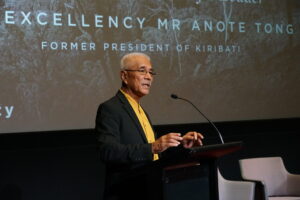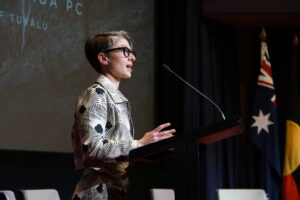by Ebony Bennett
[Originally published in the Canberra Times, 18 November 2019]
I was a cub reporter working in the press gallery for the Sydney Morning Herald when bushfires engulfed Canberra in 2003, claiming four lives and almost 500 homes. It’s seared in my memory, as I’m sure it is for a lot of Canberrans. I’ve been thinking about it a lot this week, as the Deputy Prime Minister wrote off anyone with the temerity to discuss bushfires and climate change in the same breath as “raving inner-city lunatics”.
The Saturday the bushfires hit Canberra, I was doing my grocery shopping in Belconnen Mall. Giant plumes of black smoke were visible through the skylight, while announcements periodically came over the loudspeaker about which suburbs were being evacuated. When I got to my car on the top level of the outdoor car park, it looked like the apocalypse. The sun cast an eerie orange pall over Canberra; the air was thick with smoke and filled everything with an inescapable acrid smell. When the first photos emerged of the NSW bushfires near Port Macquarie, Hallidays Point and Old Bar over the past few days – any one of which could double as a poster for a Hollywood disaster movie – I was instantly taken back to our “darkest day”, as the Canberra Times editor Grant Newton described it.
My flatmates and I spent all the afternoon glued to ABC 666 for emergency announcements. Our suburb was fortunately not under threat, but we listened in real time as the fire hit Duffy, clearly catching both residents and reporters by surprise. It was only later that the full picture emerged of the horror of that fire.
I was sent to interview people in the devastated suburbs of Chapman and Duffy. Entire streets were reduced to rubble, though sometimes a lone house had survived. The heat was still intense. I spoke to one bloke who had managed to save both his and his neighbour’s houses from burning down with his garden hose. He was devastated because he could not save the houses across the road and watched them burn one by one from ember attacks. Another family had arrived back from a holiday to find their home in ashes, still smouldering, with only the letterbox still standing. Most of the people I interviewed were just thankful to be alive, shocked and sad, but eager to reassure me that other people had it worse than them. But more than 15 years on, I’m sure the sadness and loss still linger for many of those families whose homes were destroyed. Canberra cannot afford to forget.
Just as people who live here in the bush capital are so often dismissed by the government as living in “the Canberra bubble”, it’s easy for the government to dismiss Adam Bandt as an “inner-city lunatic” for linking climate change to the bushfires we are seeing today. But the fact is, a lot of our knowledge when it comes to preparing for bushfires comes from bitter lessons learned in the aftermath of a conflagration that caught the nation’s capital city underprepared. And in silencing the discussion about the impact of climate change, the government is silencing not just the Greens, but the experts whose only interest is to help avoid days like the one Canberra experienced that Saturday in 2003, and Victoria experienced in 2009 when 173 people lost their lives. We cannot afford to narrow the bushfire debate to suit anyone’s political interests. Everything must be on the table.
The dangers of making climate change part of the culture wars have rarely been so stark. As far back as 2006, the Australia Institute released research showing that climate change makes bushfires worse – work the CSIRO began in the ’80s. Obviously, the government does not read every single Australia Institute report. But I never thought I’d see the day 23 former fire and emergency chiefs would more or less have to beg to meet the government just because they want to discuss the impacts of climate change on bushfires.
It is unconscionable for the government to ignore the concerns and advice of the very people they are sending to the front lines. Our Rural Fire Service is primarily made up of volunteers. Every summer we rely on people to voluntarily give up their time and safety to fight fires that former chief of NSW Fire and Rescue Greg Mullins says have been supercharged by climate change. NSW Rural Fire Service Commissioner Shane Fitzsimmons described conditions as “uncharted territory” and said NSW had never had so many simultaneous fire warnings. Parts of Queensland are on fire that were never expected to burn. And it’s not even summer yet.
Politicians are right to say that bushfires have always been a part of Australia. Most people understand that bushfires are a threat that can never be solved, only managed. But before the federal government dismisses the concerns of “woke” capital city residents, it should remember that it’s thanks to the bushfires that devastated the nation’s capital that we now have a better understanding about bushfires, including how they can create their own weather systems, known as firestorms, and how to identify these conditions ahead of time to better prepare both residents and emergency services personnel.
Now firefighters must manage a bushfire season that starts earlier and lasts longer. We used to be able to share firefighters and equipment, borrowing from the US and Canada during their winter, but our bushfire seasons increasingly overlap. And as bushfire season is getting longer, the weather hotter and the humidity drier, the window for hazard-reduction burning is getting shorter in winter. We are asking more of our firefighters, but we are providing them with less.
The NSW Firefighters Union says the NSW government cut its budget for paid firefighters, and NSW National Parks says it has fewer staff to conduct hazard-reduction burns thanks to an $80 million budget cut. Not only are we silencing a debate that’s critical to understanding the threat our volunteer firefighters face, we’re being cheap with the ones we do pay.
The same day Sydney was declared to be under catastrophic fire conditions for the first time, the NSW Parliament was due to debate laws shielding coal mine projects from having to address their emissions, which drive climate change. A furious NSW family dumped a bucket filled with the ashes of their home outside NSW Parliament, saying there was no better time to talk about climate change. If you had scripted that, you’d surely be accused of laying it on too thick.
Australians understand governments can’t stop bushfires. All we expect is that governments will do everything they can to reduce harm and mitigate risk. That’s why people are angry.
Australia’s emissions continue to rise, not fall. The Australia Institute’s Climate of the Nation report shows that three quarters of Australians are concerned that climate change leads to more bushfires; the science validates their concerns. We didn’t ask if people think the Bureau of Meteorology is part of a global conspiracy to change temperature records – as one Liberal senator confidently asserted this week – but at some point this summer, Deputy Prime Minister Michael McCormack might like to consider exactly who the “lunatics” really are in this debate.
- Ebony Bennett is the deputy director at independent think-tank the Australia Institute. She was a junior reporter in Canberra for the Sydney Morning Herald during the 2003 Canberra Bushfires
- Twitter: @ebony_bennett.
Between the Lines Newsletter
The biggest stories and the best analysis from the team at the Australia Institute, delivered to your inbox every fortnight.
You might also like
Navigating Australia & the Campaign to End Coal | Anote Tong
Climate change is the greatest moral challenge that humanity has ever had to face, and for those of us who have the capacity to stop it, are we going to do it?
Massive Gap Between Rhetoric and Actions on Emissions
Farmers know you can’t fatten a pig on market day and scientists know you can’t reduce greenhouse gas emissions by 2030 while expanding coal, oil and gas production.
The Climate Crisis is an Integrity Crisis | Polly Hemming
I am starting my address to this year’s summit in the exact same way that I started last year’s address. Because it is just over a year since I delivered these same words, which aren’t actually my words. They are the words of our Climate Change Minister, and they provide a baseline of sorts for what progress has been made in that time.

